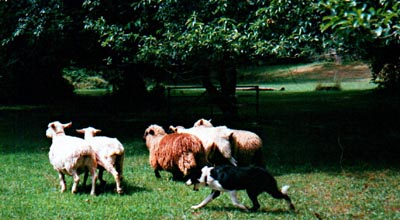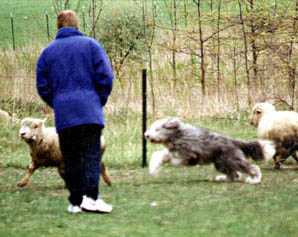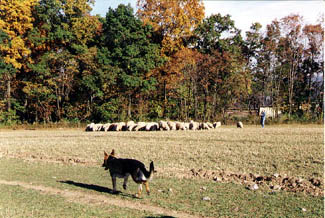|
Origins of the Border Collie
 The word "collie" comes from the informal Gaelic farm term "colley" for
"useful." Many items around the old Gaelic farmstead were prefaced by the word
"colley" for "useful" or "coley" for black. Therefore, it should not be
surprising that a "Collie" dog is useful, and, in the case of the Border
Collie, often carries characteristic black markings as well. The long history
behind the modern Border Collie breed, which originated in the border regions
between Scotland and England (hence the name "Border Collie"), includes
crossings of some of the old Collie droving breeds with some of the gun-dog,
hunting breeds to get such characteristics as the "eye" of the Border Collie,
which is very similar to the set or point of the modern gun dog hunting breeds.
The unique Border Collie "eye" is a commanding, mesmerizing gaze which the
breed uses to compel the sheep to follow the flock, guided by the dogs.
The word "collie" comes from the informal Gaelic farm term "colley" for
"useful." Many items around the old Gaelic farmstead were prefaced by the word
"colley" for "useful" or "coley" for black. Therefore, it should not be
surprising that a "Collie" dog is useful, and, in the case of the Border
Collie, often carries characteristic black markings as well. The long history
behind the modern Border Collie breed, which originated in the border regions
between Scotland and England (hence the name "Border Collie"), includes
crossings of some of the old Collie droving breeds with some of the gun-dog,
hunting breeds to get such characteristics as the "eye" of the Border Collie,
which is very similar to the set or point of the modern gun dog hunting breeds.
The unique Border Collie "eye" is a commanding, mesmerizing gaze which the
breed uses to compel the sheep to follow the flock, guided by the dogs.
History as far back as 1570 mentions the Scottish shepherds and their working
collies. We can see illustrations done in those early times showing the body
type and eye typical of today's Border Collie. However, the modern Border
Collies had their beginnings with the first organized sheep dog trials which
occurred in Great Britain in 1873. The "eye" of the breed was not universal at
that point, but with the advent of the trials, breeding practices developed the
"eye" to its prominent state today.
|
|
|
Brief History of Sheepherding in Early America
 There is very reliable proof that working collies were being imported into the
United States as early as 1800, which marked the arrival of the Cotswold,
Leicester and Merino sheep breeds as well. The early importation of working
dogs then slowed, and those that had been imported were crossed with
non-working dogs so that by 1900, few actual working dogs remained in America.
It appears that the importation of working dogs into America did not pick up
again until the 1920s.
There is very reliable proof that working collies were being imported into the
United States as early as 1800, which marked the arrival of the Cotswold,
Leicester and Merino sheep breeds as well. The early importation of working
dogs then slowed, and those that had been imported were crossed with
non-working dogs so that by 1900, few actual working dogs remained in America.
It appears that the importation of working dogs into America did not pick up
again until the 1920s.
As an interesting aside, Thomas Jefferson imported Merino and Barberry Sheep as
well as native French herding dogs similar to the modern Briard to tend them,
using his friendship with the du Ponts and the Marquis de la Fayetteto assist
him in his importation of the dogs. In his correspondence, Jefferson remarks
about the wonderful sagacity of the dogs, claiming that they had no equal as
herding or house dogs.
Modern Herding Competitions in America
Today one can find herding performance competitions for many different breeds
of herding dogs sponsored by organizations such as the American Kennel Club,
the North East Border Collie Association and the Australian Shepherd Club of
America.
 Courses can take place in an open field or a small arena and involve hundreds
of yards (or hundreds of feet), 3 to 100 sheep, and each run on a course can
take anywhere from 10 to 45 minutes, depending on the course.
Courses can take place in an open field or a small arena and involve hundreds
of yards (or hundreds of feet), 3 to 100 sheep, and each run on a course can
take anywhere from 10 to 45 minutes, depending on the course.
Breeds of dogs used in competition include Australian Cattle Dogs, Australian
Shepherds, Bearded Collies, Belgian Sheepdogs (Groenandael, Malinois, Tervuren
and Laekenois), Border Collies, Bouvier des Flanders, Briards, Collies (Rough
and Smooth), Cardigan and Pembroke Welsh Corgis, German Shepherd Dogs, Old
English Sheepdogs, Pulik, Rottweilers, Samoyeds and Shetland Sheepdogs, among
others. The Border Collie is a "strong-eyed" breed, relying primarily on its
distinctive gaze and threatening approach and stance to move sheep, while most
of the others are known as "loose-eyed", that is, they use something other than
eye to move the livestock, such as their movement (or lack thereof), bark or
grip.
Basic Commands
The basic commands used around the sheep include:
-
Come By (go clockwise around the sheep)
-
Away to Me (counter clockwise)
-
Walk Up (approach sheep)
-
Steady (move steadily and slowly)
-
Get Back Out (move away from the sheep)
-
Look Back (look behind for more sheep)
-
Lie Down (stop)
-
There (stop briefly at a point)
-
That'll Do (leave work and return)
|